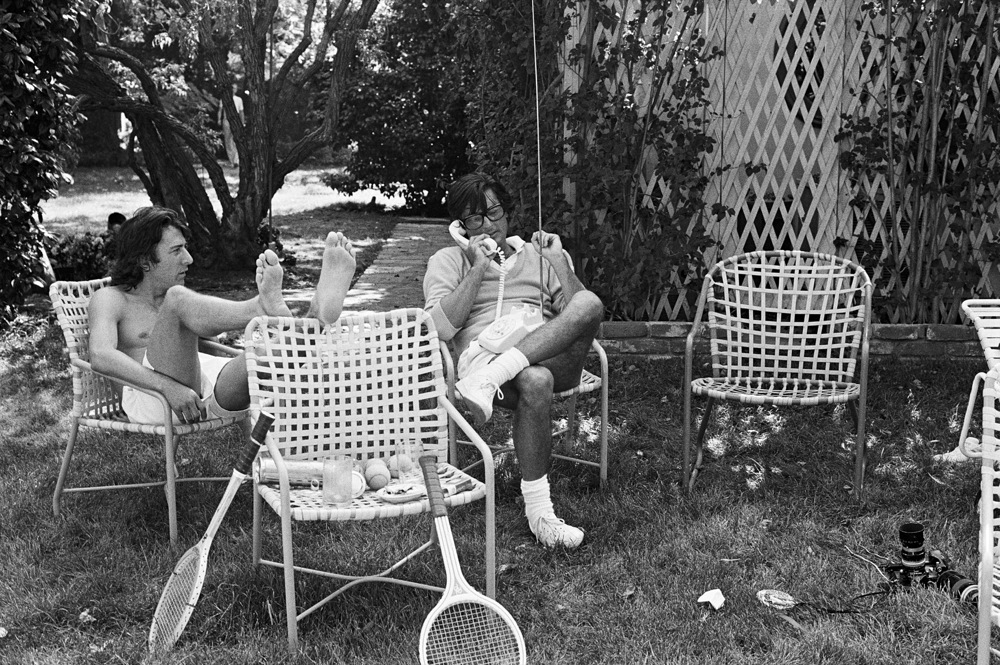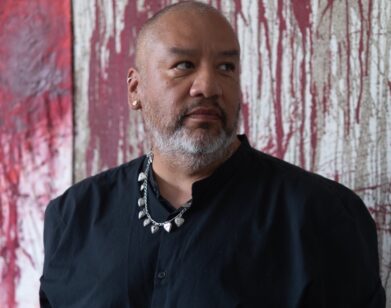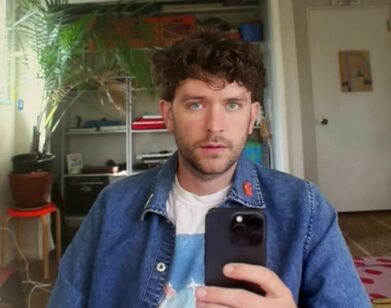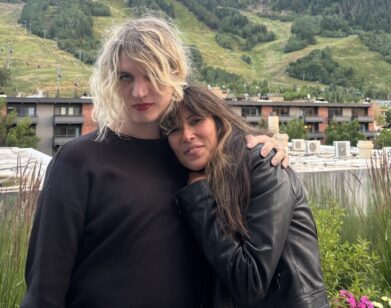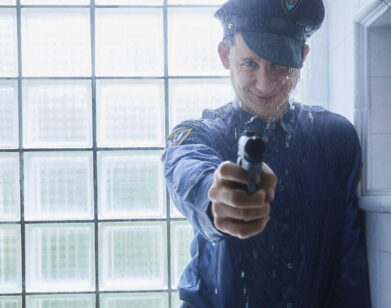On and Off Set with Brigitte Lacombe
Growing up with a father who wanted to be a photographer but wasn’t allowed, Brigitte Lacombe followed his dream and dropped out of high school at age 17 to pursue the medium. She took her first camera, a Nikon F, given to her by her father, and began working as an apprentice at Elle in Paris. Now, 40 years later and armed with Leica, Hasselblad, and Canon cameras, the photographer is having her first exhibition in New York at Phillips.
Titled “Brigitte Lacombe: Complicities,” the exhibit spans the breadth of her career, from an early portrait of Andy Warhol and a photo on the set of Kramer vs. Kramer to Sienna Miller and the set of The Wolf of Wall Street. After years of focusing on those within the film industry, Lacombe, who was born and raised in France, has been adopted into the families of notably reclusive directors, such as Martin Scorsese, and revisits certain subjects, like Meryl Streep, both of whom she has also photographed for Interview.
The images shot on set contain a sense of earnestness and intimacy, capturing still moments of contemplation and oftentimes invite the viewer to forget that a film is being made. In one image, we see Kirsten Dunst lying on a chaise lounge in the middle of the frame, while Sofia Coppola stands to the left and a woman dressed as a chambermaid sits on the right. It’s easy to dismiss the bright light beaming over Dunst, as her face is dramatically posed, and the camera is hardly seen in Coppola’s hand. It’s as if we’re looking into a dreamlike setting of friends acting out a fantasy, rather than the making of Marie Antionette. It only seems appropriate that Lacombe names the German pioneer of portrait and documentary photography August Sander as her strongest influence.
Just before the exhibition opening on Monday, we spoke with Lacombe to learn more about her childhood, the start of her career, and photographing those who are—and aren’t—in the show.
EMILY MCDERMOTT: How did you meet Dustin Hoffman at Cannes in 1975? That was a very pivotal point for you and your career.
BRIGITTE LACOMBE: Yes, very much. I met him because I was working for Elle, it was a weekly, so I had been sent to cover the festival. You could speak to the actors, or the directors, in a much easier way than now; it was a much different type of access. So I did this picture of Dustin, but I was the only woman there—there were very few woman photographers—and young, and Dustin just threw me this invitation to come and work on this next movie when I left. It tuned out to be All the President’s Men and he was about to shoot in Washington D.C. I don’t know if he thought anything of it, but I took it seriously and the magazine sent me. Then I started this friendship with him and his family, and he actually helped me get my green card. [All the President’s Men] made me come to America, and I kept coming, and then I finally moved here in the early ’80s.
MCDERMOTT: Being one of the only women photographers and being young, that must’ve been rather intimidating.
LACOMBE: I’m not sure I was completely aware of that. You know, when you’re very young, sometimes you’re not intimidated by the things you should be intimidated by, because you don’t have that many references. I just knew it was where I wanted to be and that I was very interested by that world. Ever since that year I’ve been going to Cannes almost every year.
MCDERMOTT: There are certain characters that appear in your work throughout the years, like Scorsese. Is that because you’re friends with these subjects? Or what makes you return to them?
LACOMBE: There’s all kinds of different situations with so many years and so many people that I photograph. In the case of Martin Scorsese, it’s a very close team of collaborators and I’ve been folded in. He’s extremely loyal. He accepts very few people. It’s always a closed set and I’m the only photographer admitted in, except the set photographer, which is very different work. Any projects he works on—documentary, or anything—I will really make the time and visit and take a picture because it’s one of my most…not prideful…the most wonderful…
MCDERMOTT: The most meaningful?
LACOMBE: Yes, it really is. He is a very extraordinary man, and very generous, and I love his work. There are other relationships with other people, like Meryl Streep, that I just photograph from project to project, whenever I can. Some photographers, once they have a photo of someone, they are happy to move on to other people, but I love to keep returning to the same person, the same group. It keeps me interested because they are extraordinary people, they have much to observe and offer. Every project is different.
MCDERMOTT: I wanted to ask about the Warhol portrait, particularly because it’s Interview. What was the experience like?
LACOMBE: I was in Paris and he was visiting. I’m not sure what he was doing, but he was staying with some friends in rue du Cherche-Midi, which is next to where I lived. I was working for Elle and they asked me to go take this picture of him. I remember it was a modest, wordless encounter. I was very young; it was the beginning of taking portraits for me. He was sitting on this sofa, and that’s really the only image I did. It’s not like I posed him there; it was the way I found him and left him. He was quite a mysterious character, for me, at the time.
MCDERMOTT: Going back to your childhood, how did your father’s interest in photography foster yours? When did you first become interested in the medium?
LACOMBE: It was mainly that my father wanted to be a photographer and was not allowed by his family because they felt it was not a secure profession. It was right after the war, when he was growing up, and they felt he needed something more stable. But he always wanted to take pictures and he did take pictures all the time. That was really what interested me. Then I dropped out of high school to become a photographer, and it’s only by actually doing it and doing it, and becoming more and more focused, that it turned out to actually be a vocation for me. When you’re 17 years old, you don’t really know that you’re picking something for the rest of your life; I was really lucky to have chosen photography.
MCDERMOTT: What is one of the first photos that you took that you were incredibly proud of?
LACOMBE: To be honest with you, I don’t remember the very first time, but there’s two images from very early on that I still feel that way about: I actually do love the Andy Warhol image, and there’s another image that is not in the exhibit, but is of the director Elia Kazan. These two images are from the late ’70s. It’s not only the image that counts for me; it’s the moment. It’s the moment of the intensity and the quality of the image that is absolutely fantastic. In this case it was, for both of them.
MCDERMOTT: What’s it like doing portraits versus working on movie sets? How does your approach differ?
LACOMBE: It’s completely different because on movie sets you hide and the situation is presented to you, so you record what is presented. On a movie set you are not exactly the most important person—you’re actually the least important person—so you record the situation that is presented. For portraiture it’s the opposite. I set the situation that I want and bring people in it.
MCDERMOTT: So how does your mindset change? What are you thinking when you’re making a portrait opposed to when you’re on set?
LACOMBE: It’s the same. You need to be incredibly focused, and 100 percent present in the moment. On a movie set, you need to be incredibly quiet and gentle, but at the same time, very forceful and determined. For the portrait it’s the same. I know that once I set the tone by bringing people to a set that I want—meaning the lights, the intimacy of the space, the quietness, and the fact that I stay one-on-one with them—I’m asking for the person in front of me to collaborate with me. It’s not just me imposing something; I want an exchange.
MCDERMOTT: What are some of the most memorable experiences that you’ve had?
LACOMBE: One of the most incredible moments was when I did a portrait of Nelson Mandela. That was a very extraordinary moment to be, actually, on top of it. I was working with my Hasselblad, so you have to be quite close to the person. It’s a medium format, you see the image quite big, and to really be looking into the face of this extraordinary man was quite something. That, for me, was a really important moment. I was in South Africa, in Johannesburg, at his place. I’ve done so many portraits, there’s many people I’m interested in, but easily this is “the one.”
MCDERMOTT: You work basically every day, but what do you do in your rare spare time?
LACOMBE: I used to do many more things, but now that I travel nine months out of the year, when I finally have a moment I just lie down and read. That’s it. That’s the way I recover.
MCDERMOTT: What do you read, or what are you currently reading?
LACOMBE: I’m sorry to say I’m just reading The New York Times, the Financial Times, and the New Yorker…I’m just reading online. I’m keeping up very much with what’s going on in the world. To get lost in a book, which as we know is the most extraordinary feeling, you have to have more time than just a day or two here and there. So when you stop, you can go back to true reading.
“BRIGITTE LACOMBE: COMPLICITIES” IS ON VIEW THROUGH JULY 6 AT PHILLIPS IN NEW YORK. FOR MORE ON THE ARTIST, VISIT HER WEBSITE.

